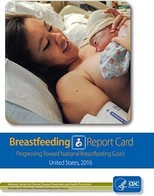
Breastfeeding Rates Continue to Rise in the United States

For nearly all infants, breastfeeding is the best source of infant nutrition. In addition, breastfeeding provides health benefits to both the baby and the mother. The American Academy of Pediatrics (AAP) recommends that infants are breastfed exclusively for about the first 6 months and that breastfeeding continue for at least 12 months, and thereafter for as long as mother and baby desire. To track the nation’s breastfeeding progress, the CDC’s Division of Nutrition, Physical Activity, and Obesity (DNPAO) uses CDC’s National Immunization Survey (NIS). This data allows us to measure whether we are meeting the nation’s breastfeeding targets, as outlined in Healthy People 2020. We also measure different types of breastfeeding supports available for moms and their babies, such as maternity care practices in hospitals, child care facility protocols, and the number and types of lactation support providers in communities. |
What’s new this year?
Among babies born in 2013
- 4 out of 5 started out breastfeeding.
- Over half were still breastfeeding at 6 months of age and almost one third at 12 months.
- 82.7% of Puerto Rican infants started out breastfeeding. This is the first time Puerto Rico’s rates are included in the Breastfeeding Report Card.
Some states are on their way to meeting national breastfeeding goals; others have a ways to go.
- 29 states, including DC and Puerto Rico, have already met the Healthy People 2020 objective of 81.9% ever breastfed.
- Only 12 states met the Healthy People 2020 breastfeeding objective for 6 months duration (60.6%).
- Only 19 states met the Healthy People 2020 breastfeeding objective for 12 months duration (34.1%)
Many hospitals are making strides to implement maternity care practices that support breastfeeding.
The percentage of live births occurring at hospitals that have been designated Baby-Friendly by theBaby-Friendly Hospital Initiative increased from 7.8% in 2014 to 18.3% in 2016, an encouraging trend in improved maternity care practices that support mothers and infants.
View the Breastfeeding Report Card to see the most recent national and state data on breastfeeding and supports for breastfeeding.
More Information:






















.png)











No hay comentarios:
Publicar un comentario